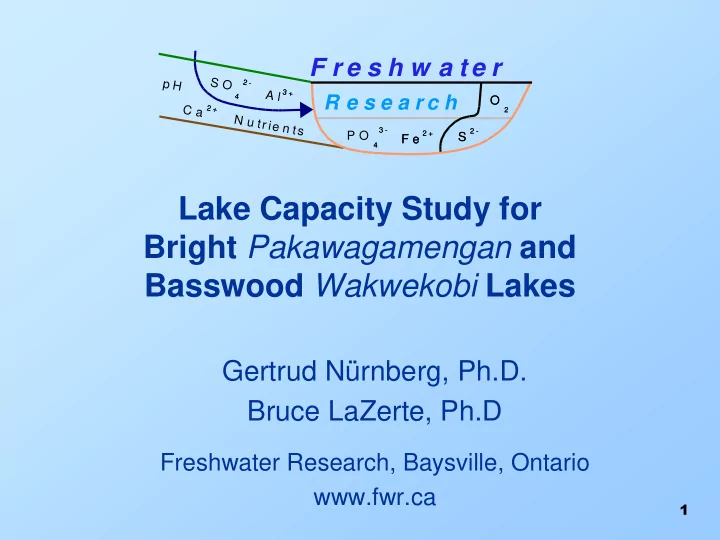

F r e s h w a t e r S O p H 2 - 3 + 3 A l 4 R e s e a r c h O C a 2 + + 2 N u tr ie n ts 3 - 3 2 2 - P O 2 2 + S F e 4 Lake Capacity Study for Bright Pakawagamengan and Basswood Wakwekobi Lakes Gertrud Nürnberg, Ph.D. Bruce LaZerte, Ph.D Freshwater Research, Baysville, Ontario www.fwr.ca 1
Thanks • You • Town of Huron Shores and staff • Ray Lipinski, MNR • East Algoma Stewardship Council (MNR - WS) • Walter Shields, MOE • Bright Lake Association, John & Peggy Milito • Ontario Trillium Foundation • Central Algoma Freshwater Coalition (Desbarats Lake) • Jon Cavanagh, Lake Partner for Basswood • John Fullerton † , sampling support Basswood 2
John Fullerton 19 Sep 2010 3
About: • Bright and Big Basswood lakes & watershed • Water quality (studies, evaluation, internal load) • Developmental Capacity – Phosphorus mass balance – External & internal load – Scenarios: what happens if? • Remediation needed? How? • Recommendations 4
5
Lake shapes 3 m contours Characteristics Bright Basswood Surface Area, Ao (km²): 12 27 Watershed Area, Ad (km²): 174 61 Ratio of areas Ad/A o : 14 2.3 Maximum Depth,(m): 12 73 Mean Depth, z (m): 4.9 38 Morphometric Index (z/A 0.5 ): 1.4 7.3 Volume (10 6 m³): 60 1,022 6
Schematic connections between lakes 7
Stages during the eutrophication process 1 1 2 2 3 3 4 4 8 Nürnberg & LaZerte 2004
Water Quality Trophic State Classification Oligo Meso Eu Hyper Bright Basswood trophic trophic trophic eutrop hic Secchi 2.2 11.3 > 4 2 – 4 1 – 2 < 1 Transparency (m) Total phosphorus 14 4.2 10 10 – 30 31 – 100 > 100 (µg/L) Chlorophyll a 6.3 NA < 3.5 3.5 – 9 9.1 – 25 > 25 (µg/L) 9
Internal phosphorus load and blooms Bluegreens (Cyanobacteria) thrive in high temperature, high P concentration and low- flow conditions • High temperature: High sediment P release rates & oxygen demand; low oxygen in water • Dry spells & low flow: High internal versus external load 10
Indications of internal load in shallow, unstratified lakes • Seasonal: Increasing TP throughout summer • Mass balance: – Less TP retained than predicted (from q s ) – More TP leaving the lake than entering (negative retention) • Blooms, increased turbidity throughout summer • Thin oxic sediment layer; occasional anoxia in weed beds, at quiescent conditions (early morning) in the bottom water • Occasional iron, manganese or reduced gas development at quiescent conditions 11
A Sampling Sites B C D Sharla Shine
Dissolved Oxygen (mg/L) Bright Basswood 7 mg/L 19 Sep 2010 13
Basswood Oxygen for Trout • Minimum volume-weighted hypolimnetic DO of 7 mg/L measured within 2 weeks of August 31 and adjusted to Sept 15 conditions Ministry of Natural Resources 2006 Criteria for Lake Trout Lakes, used to determine lake development capacity 14
Bright Lake: Secchi 15
Bright Lake: Total Phosphorus (TP) 2010 2009 16
Basswood: Secchi & Phosphorus Summer averages Bright 17
Monthly averages of Secchi transparency for Basswood Lake 18
Internal Phosphorus Load Are the nutrients that cause algae problems in the sediments or coming from outside the lake? Bright Lake Internal Load estimates (kg/yr) Bright Lake Sediment Model estimates 542-1567 In situ increases estimates 1590 External Internal Input for capacity study 1,540 Load Load Basswood 51% 49% Input for capacity study 0 Sharla Shine
20 MNR, May 2010
Bright Lake Watershed: Areal and loading proportions 21
Phosphorus load Areal load (mg/m 2 /yr) 36 139 + 125 22
Basswood Anthropogenic Load (190 kg/yr TP) Farms Roads Camping Resort Cottage 23
Bright Anthropogenic Load (470 kg/yr TP) Upstream Basswood Cottage Camping Roads Farms 24
Basswood Lake characteristics and model results for different scenarios Conditions & Scenarios TP Chlorophyll Secchi (µg/L) (µg/L) (m) Observations 4.6 na 11.3 Scenarios: • Present 4.9 2.2 9.6 • Pristine 4.0 1.8 10.6 • Capacity (1.5 x Pristine)* 6.0 2.5 8.8 • Vacant developed 5.1 2.2 9.5 *e.g., double shoreline development and agriculture 25
Bright Lake characteristics and model results for different scenarios Conditions & Scenarios TP Chlorophyll Secchi (µg/L) (µg/L) (m) Observations 13.8 8.4 2.2 Scenarios: • Present 15.1 5.7 3.36 • Pristine 4.0 1.8 6.14 • Capacity (1.5 x Pristine) 6.0 2.6 5.10 • Vacant developed 15.3 5.8 3.35 • With Basswood at capacity 15.4 5.8 3.34 26
What to do: External load From shoreline and agricultural areas Consult programs, help farmers, educate • Septic systems inspection and maintenance • Best management practices • Agricultural practices, fencing • Erosion control • Planting along creeks 27
Internal load abatement • Chemical precipitation (aluminum, iron, calcium) • Adsorption and settling (clay, Phoslock TM ) • Hypolimnetic withdrawal • Aeration, oxygenation, destratification • Sediment capping or removal (dredging) These remediation technologies are too costly because of Bright Lake’s size and remote location. 28
Lake Levels affect water quality in Bright Lake? Spring Sharla Shine
The Sequence of Events May Be ... Precipitation + Beaver Dam Activity in the outflow High Lake Levels Stratification Anoxic, Stagnant Conditions Internal P load Cyanobacteria Blooms Sharla Shine
Recommendations: Monitoring • Basswood – Monitor for fish: Oxygen, biomass (MNR) – General water quality, WQ: Secchi & TP (MOE Partner Program) • Bright – WQ: Oxygen, Secchi, TP, TN (intensive program in addition to MOE PP) – Algae: chlorophyll, bluegreen taxonomy (intensive program) 31
Recommendations: Bright – Recognize it is at Capacity (Municipality) – Collect missing information: • Hydrology • Upstream lakes’ limnology and WQ – Test lake level hypothesis: • Monitoring • Collection of historic knowledge – …. and act: • Optimize lake level • Beaver dam management • Flushing with good quality Harris Creek water 32
33
Recommend
More recommend